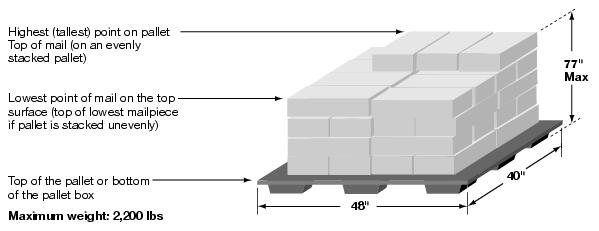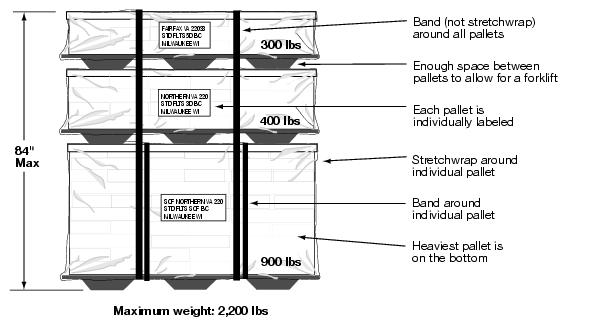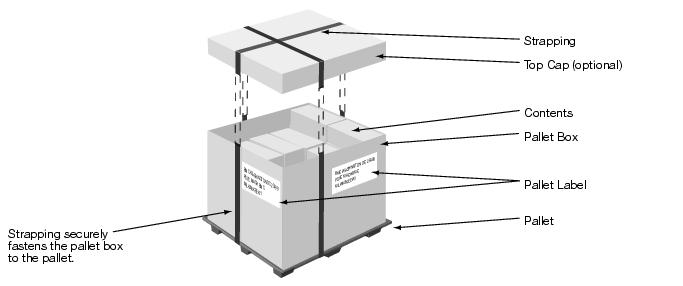|
|
|
Quick Service Guide 705bSpecial StandardsPallets, Pallet Boxes, and Trays on PalletsMay 2007 General (705.8.1) Pallets are plastic or wooden platforms upon which mail (trays, sacks, bundles, or parcels) is stacked. The Postal Service supplies pallets to mailers. Dimensions (705.8.0) Pallets measure approximately 40 inches x 48 inches. Height: Weight:
Labels (705.8.6) Pallets are labeled according to content and destination of the mail. At least two clearly visible labels must be affixed to two adjacent sides of each pallet. Use pink labels for Periodicals or white labels for Standard Mail and Package Services. Labels must be at least 8 inches x 11 inches; lettering for required information must be at least 1/2 inch high. Top Caps (705.8.2) Top caps may be used on any pallet. They must be used on stacked pallets when individual pallets do not have a sturdy, flat top surface. Top caps must be strapped or stretchwrapped onto the pallet. Mailers must supply their own top caps. Strapping and Stretchwrap (705.8.1.3) Each pallet must be secured with at least two straps or bands or be wrapped with plastic stretchwrap (or both). Stretchwrap must be wrapped completely over the lip of the pallet. Stretchwrap is preferred for most pallets. Stacking Pallets (705.8.3) Pallets may be stacked to a maximum of four high or 84 inches. Individual pallets must be strapped or stretchwrapped (or both); the entire pallet stack must be securely banded (not stretchwrapped). The heaviest pallet must be on the bottom of the stack; the lightest pallet must be on the top. There must be enough space between pallets to allow for a forklift. Measuring a Pallet Measuring points on a pallet are shown on reverse. How a pallet is measured is determined by the type of container (e.g., trays vs. sacks) and the type of discount. See individual Quick Service Guides. For the specific DMM standards applicable to this category of mail, consult the DMM sections referenced above and the general sections within each DMM module.
General (705.8.4) A pallet box is a sturdy corrugated fiberboard box placed on a pallet. Pallet boxes may be filled with sacks or parcels (machinable or nonmachinable or both depending on rate category). Mailers must supply their own pallet boxes, which must meet the requirements in 705.8.4. Dimensions (705.8.4) Pallet Box (without pallet) Base: 40 inches x 48 inches Height: Pallet Box with Pallet Height: The contents may not stick up over the rim of the pallet box. Weight: Labels (705.8.6) Pallet boxes are labeled according to content and destination of the mail. See individual QSGs. At least two clearly visible labels must be affixed to two adjacent sides of each pallet box. Use pink labels for Periodicals and white labels for Standard Mail and Package Services. Labels must be at least 8 inches x 11 inches; lettering for required information must be at least 1/2 inch high. Top Caps (705.8.2) Top caps are not required on single pallet boxes; they are required on stacked pallet boxes. Top caps must be securely fastened onto the pallet box and pallet. Strapping and Stretchwrap (705.8.4) Each pallet box must be securely strapped or stretchwrapped (or both) to its pallet for safe transport (except when the pallet is accepted at the postal facility where the contents are distributed and the weight of the mail in the box will hold the box in place during transport and processing). Stacking Pallets of Pallet Boxes (705.8.3) Pallet boxes may be stacked to a maximum of four high or 84 inches. Individual pallets must be strapped or stretchwrapped (or both); the entire pallet stack must be securely banded (not stretchwrapped). There must be enough space between pallets to allow for a forklift. Measuring a Pallet Box Measuring points on a pallet box are included in "Pallet Measurements." See individual QSGs for how to measure mail for specific discounts.
General (705.8.10) Trays are stacked on pallets so that many trays can be moved as a single unit. Trays must be individually sleeved, strapped, and labeled. See 705.8.3.5 for exception to the strapping requirement. Any combination of trays ( 1-foot, 2-foot, EMM) can be stacked on the same pallet, as long as the finished pallet is sturdy and meets all height and weight requirements. Trays may not be combined with other containers (parcels, sacks) on the same pallet. Dimensions (705.8.5) Height:
Weight: Labels (705.8.6) Pallets are labeled according to content and destination of the mail. See individual QSGs. At least two clearly visible labels must be affixed to two adjacent sides of each pallet. Use pink labels for Periodicals and white labels for Standard Mail and Package Services. Labels must be at least 8 inches x 11 inches; lettering for required information must be at least 1/2 inch high. Top Caps (705.8.2) Top caps are not required except when pallets are stacked. If used, top caps must be stretchwrapped or banded onto the trays and pallet. Stretchwrap (705.8.14.5) Stretchwrap must be used to secure the trays to the pallet and must be securely wrapped around the pallet. Banding alone is not permitted. Tips on Stacking Trays Trays should be counter-stacked where possible to build the sturdiest pallet possible. It is easy to build a very sturdy locking pallet of all 2-foot trays (see diagram below for recommended method). All trays on a pallet should be stacked right-side-up with labels facing outward (where possible). Stacking Pallets of Trays Pallets of trays may be stacked to a maximum of four high or 84 inches. Individual pallets must be stretchwrapped; the entire pallet stack must be securely banded (not stretchwrapped). There must be enough space between pallets to allow for a forklift.
|





